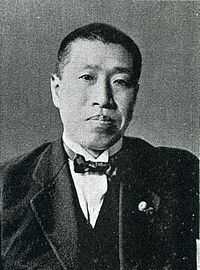Ryūtarō Nagai
| Ryūtarō Nagai 永井 柳太郎 | |
|---|---|
 Ryūtarō Nagai | |
| Born |
April 16, 1881 Kanazawa, Ishikawa, Japan |
| Died | December 4, 1944 (aged 63) |
| Nationality | Japan |
| Occupation | Politician, Cabinet Minister |
Ryūtarō Nagai (永井 柳太郎 Nagai Ryūtarō , April 16, 1881 – December 4, 1944), was a politician and cabinet minister in the Empire of Japan, serving a member of the Lower House of the Diet of Japan eight times, and four as a cabinet minister.
Biography
Nagai was born in Kanazawa, Ishikawa Prefecture, where his father had been a samurai in the service of the Maeda clan. Nagai was a student at Waseda University, and at the recommendation of Okuma Shigenobu, travelled to Oxford University in England for further studies before graduating from Waseda with a degree in Colonial Studies.
Nagai ran for a seat in the Lower House of the Diet during the 1917 General Election, but was defeated by the Rikken Seiyūkai candidate Nakahashi Tokugōrō by only 203 votes. For the 1920 General Election, Nakahashi changed his electoral district to Osaka, and Nagai was elected. He retained his seat over the next seven elections, eventually rising to the position of Secretary-General of the Rikken Minseitō political party. Nagai was known for his strong oratory, combining ponderous speech with colorful or flamboyant phrases. (He was once censured by the Diet for making a congratulatory speech on the inauguration of Prime Minister Hara Takashi by comparing Hara’s victory to that of Lenin in the Soviet Union).
In May 1932, Nagai was picked to be Minister of Colonial Affairs under the Saitō administration, which he held until July 1934. In June 1937, he was selected to be Minister of Communications under the Konoe administration, until January 1939 and returned to the same post from August 1939 to January 1940 under the Abe administration. Also under the Abe administration, he served as Railroad Minister concurrently with his term as Minister of Communications. He was awarded the Order of the Rising Sun, 1st class.
A leading member of the pro-military clique within the Rikken Minseitō, Nagai was a member of the League of Diet Members Carry Through the Holy War and a key supporter of Konoe’s plan to create a single-party state under the Taisei Yokusankai. Under the war-time regime, he was appointed a political bureau chief for Greater East Asia Development Board, and also founded the “Greater Japan Scholarship Foundation”, the predecessor to the modern Japan Student Services Organization.
Nagai died in 1944, shortly after the Tokyo Air Raid, which he felt partly responsible for.
Michio Nagai, Minister of Education in the Miki administration was Nagai’s eldest son.
References
- Sims, Richard (2001). Japanese Political History Since the Meiji Renovation 1868-2000. Palgrave Macmillan. ISBN 0-312-23915-7.
| Political offices | ||
|---|---|---|
| Preceded by Yonezō Maeda |
Railway Minister Aug 1939 - Nov 1939 |
Succeeded by Hidejirō Nagata |
| Preceded by Harumichi Tanabe |
Minister of Communications Aug 1939 - Jan 1940 |
Succeeded by Masanori Katsu |
| Preceded by Hideo Kodama |
Minister of Communications June 1937 - Jan 1939 |
Succeeded by Suehiko Shiono |
| Preceded by Toyosuke Hata |
Minister of Colonial Affairs May 1932 - July 1934 |
Succeeded by Keisuke Okada |